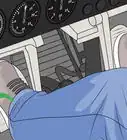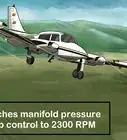This article was co-authored by Javier Diaz. Javier Diaz is an Entrepreneur & Stunt Helicopter Pilot, and owner of Wings Air Helicopters LLC. With over 20 years of flying experience, his company specializes in helicopter charters, tours, flight training, and aerial film production. He earned his BS from the United States Merchant Marine Academy and is a member of the Screen Actors Guild (SAG). As a Stunt Pilot, Javier has many major film credits, including several blockbuster films.
There are 25 references cited in this article, which can be found at the bottom of the page.
wikiHow marks an article as reader-approved once it receives enough positive feedback. In this case, 100% of readers who voted found the article helpful, earning it our reader-approved status.
This article has been viewed 123,827 times.
This article focuses on taking you through all of the basics for the six instruments in a Cessna 172, one of the most common aircraft. The Cessna 172 is illustrative of all similar types of aircraft. Moreover, if needed, you will be able to understand the more complex glass panel instruments and controls of newer and larger aircraft.
The framework for piloting an airplane consists of:
- learning the most-used instruments and controls
- becoming familiar with communication and navigation
- performing the pre-flight procedure
- obtaining clearance and taking off
- in-flight maneuvering
- obtaining clearance and landing
Mastering the below steps will take you a long way to passing your pilot's ground school exam, flight test, and getting your pilot's certificate.
Steps
Learning About Aircraft Instruments
-
1Study a Cessna 172 aircraft instrument panel. It is a standard aircraft panel with six round "basic flight instruments," often called the six pack. These are the ones in the center, directly in front of the pilot's seat.[1]
-
2Familiarize yourself with the six pack. The six instruments are located on the instrument panel in the following order:[2]
- Top left - The Airspeed Indicator shows aircraft airspeed, usually in knots. (A knot is one nautical mile per hour—about 1.15 MPH or 1.85km/hr).
- Top center - The Artificial Horizon shows the aircraft attitude and whether the plane is climbing or descending as well as whether it is in a bank to the left or to the right.
- Top right - The Altimeter shows the height (altitude) of the aircraft in feet MSL—feet above mean, or average, sea level.
- Lower left - The Turn and Bank Indicator is a dual instrument which tells what angle of bank you are in during a turn (rate of turn) and also whether you are in co-ordinated flight and feeling the proper, down-in-the-seat G-force from the turn. This is also called the "Turn and Slip Indicator" or "Needle Ball."
- Lower center - The Heading Indicator shows the aircraft's current compass heading. This instrument needs to be calibrated on a regular schedule.
- Lower right - The Vertical Speed Indicator tells how fast the aircraft is climbing or descending.
- Note: The two round instruments directly to the right of the six pack are dual VOR (VHF Omni-directional Range) instruments, and to the right of them are two identical VOR radios, used for communications and VOR navigation
Learning Aircraft Controls
-
1Study the aircraft controls. The necessary controls for flying this plane are:[3]
- Throttle – a black knob – When pushed forward, the engine speed increases and when pulled back, the engine speed decreases. Full back is idle speed.[4]
- Fuel mixture – a red knob – Pushed full inward is the richest mixture (used for sea level takeoffs and landings). Full back will shut the engine off. Only pull the red knob fully out when you are on the ground and ready to shut down the engine.[5]
- Carburetor heat – Used to warm the engine air intake in icing conditions, notably on long descents with the engine at low power or idling, conditions which result in a cold engine paired cold air which often cause icing.[6] Note: For all practical purposes, this has to be either full-on or full-off.
- Flaps – a flat handled switch – Used to select the wing flap positions. Flaps are usually deployed to slow the aircraft to a safe speed in preparation for landing. Note that the flaps should be advanced notch-by-notch; one position (10°) at a time.
- Fuel tank select – A Cessna 172 will almost always be set on "Both Tanks."
- Yoke ("steering wheel") – This sets the attitude (climb and turn) and the speed of the aircraft. Use small pitch adjustments, in and out for pitch (to climb or descend). Turn the yoke left and right to bank the aircraft.
- Rudder pedals – These are operated by your feet. Press the top edge of the pedals and the brakes are applied. Pressing the lower part of the pedals allows steering while on the runway.
- Control trim – There are two trim wheels in the panel. One trims the aileron and the other trims the rudder, thereby reducing the control pressure required to operate the respective controls. Trimming allows you to more easily maintain your direction of flight. Take care not to over-trim when landing as you may then not have enough pitch control to gain altitude quickly in case of a go-around (aborted landing).
-
2Learn the instruments and controls. Sit in the aircraft and spend time there just studying each instrument.[7]
- Quiz yourself on each of the instruments. You should be able find and name each instrument at a glance, even in a darkened cockpit environment and also describe the information you get from each instrument.
- Look at the gauges and see if you can describe the instrument and know how you would use its readings to adjust your flight path.
- It is highly recommended that you spend enough time in the aircraft to be comfortable with all of the instruments and feel like you have them mastered.
-
1Become familiar with the communication equipment.
-
2Purchase an aviation sectional chart. Before you begin, purchase the chart at your local airport, online, or at a pilot's store, then study the chart carefully. Find your local airport, taking particular note of your airport's required communication and navigation frequencies.
- Find a radio manual and set up the radios at the required frequencies to communicate with:
- The following order is an example for most cross country flights.
- ATIS, Automatic Terminal Information System.
- Airport Ground Control.
- Airport Tower.
- Airport Departure Control.
- Flight Service Stations.
- ATC, Air Traffic Control.
- Airport Approach Control.
- The Aviation Emergency Frequency.
- Commit the emergency frequency to memory, but do not test it.
- Listen to these frequencies. If you're not yet a pilot, don't talk on them. However, if you are a new student, you can tune in to the ground control frequency and ask Ground Control for a radio check.
- Alternatively, your flight instructor will provide you with this information. Make sure to ask questions about anything you are unsure of.
- Practice changing between frequencies. You should practice switching among the frequencies you need to use at your airport until this becomes second nature and you can switch and tune frequencies easily and naturally.
-
3Learn the VOR (VHF Omni-Directional Range).[8]
- VOR. A dual navigation system that will guide you from your departure to your destination accurately and reliably. VOR navigation is most important in IFR approaches, but is no longer the only option when visibility is poor, GPS has been taking the place of VOR. in some aspects like VFR flights and even ILS type approaches.
- Look at your sectional chart for your local airport and/or nearby VOR stations. If you have the VOR manual you should be able to listen to the VORs and even test your VOR instruments for accuracy by viewing them on the aircraft panel.
- Alternatively, your instructor will show you how to set up the VOR instruments and provide you with the required VOR frequencies.
- Practice setting up your local airport VOR frequency while you're on the ground. Some day it might be handy when you have to return to your airport after takeoff because you suddenly encounter poor visibility.
- Most airports have a VOR Test spot on the field called compass rose, (Refer to airport diagram below). Taxi over to the "Compass Rose" test area and turn on the VORs in your aircraft. Your VORs should each be within 4 degrees of the required heading.
- Depending on where you intend to fly, however, you will need to master the GPS.
-
4Learn the GPS (Global Positioning System).[9]
- GPS is a navigation system that will guide you from departure to destination accurately and reliably.
- Now that GPS systems have (WAAS) Wide Area Augmentation System, making GPS as accurate as VOR ILS systems.[10]
- Most aircraft now have GPS and some experienced pilots even a carry on handheld GPS. These hand helds not legal for guiding the aircraft, but it still comes in handy from time to time.
- Turn on the GPS and you'll see a display similar to your car GPS. However, the aircraft version is such that you'll probably have to spend many hours to become really good at programming and interpreting the GPS display (and this should be your goal).
-
5Learn the ADF (Automatic Direction Finder).[11]
- The ADF system is a great backup system that will show you where you are using a system that seeks out any local ADF ground station or any public AM radio signal and points to the signal source.
- If you turn and fly the direction the needle points it will take you directly to the ground station. You will know when you fly over the station. The needle will switch 180 degrees and point directly behind the aircraft.
- This system makes an accurate and simple navigation aide.
-
6Become familiar with the Transponder. The Transponder is a panel mounted instrument for sending your aircraft position, and altitude to ATC so they can track your aircraft for safety to you and to other aircraft.[12]
- ATC may ask you to turn on your transponder and set it to "send" (Squawk 1200) (pronounced Squawk one two zero zero). 1200 is the code for just a general VFR flight cruising around, or in a practice area.
- For instance, If you should have a radio failure in flight, squawk 7600 (pronounced seven six zero zero) so ATC will know your problem.
- ATC will give you a code to enter into your transponder based on the type of flight you'll be making.
- Study the manual on this transponder and learn all the other modes of operation there are.
-
7Get to know the DME (Distance Measurement Equipment).[13]
- Accurately measures, and displays, in nautical miles, the straight-line distance to your destination.
- This is most useful in landing approaches.
-
8Learn the Marker Beacon system. Marker Beacons are a three light radio beacon system.[14]
- This gives you a flashing light, on your panel, with a beeping sound (when your aircraft is exactly over each of the markers) showing your exact positions in the final approach to an airport.
- The three markers are called, Outer Marker, Middle Marker, and Inner Marker, placed in three spaced positions down the centerline of the ILS (Instrument Landing System).
- This system is designed to not waste any time of the pilot having to look for the instrument.
-
9Prepare For the Latest in Navigation Safety.
- ADS-B, or (Automatic Dependent Surveillance-Broadcast), is a cornerstone of Next Generation air traffic modernization.[15]
- Mandated soon by the FAA for all aircraft operating in airspace that now requires a Mode C transponder must be equipped with ADS-B.
- This new system, when properly installed and operated, will allow the pilot to see, and be seen, and avoid all other aircraft in the vicinity.
- In addition to aircraft traffic, in flight services and weather information can also be supplied to the pilot.
Completing the Pre-Flight Procedure
-
1Perform the pre-flight inspection. Before taking off, it is important to perform a walk-around examination. This is a visual inspection of the aircraft to verify that the airplane components are in good working order. Your instructor should provide you with a more detailed and highly useful operating checklist, not just for the walkaround but for all the specific airplane procedures that cover the other phases of flight.[16]
-
2Complete a thorough "walkaround." Follow the pre-flight check list in the aircraft manual or one obtained from your instructor. The most important required items will be listed in the pre-flight checklist. Some are:[17]
- Check control surfaces. Remove any control locks and make sure your ailerons, flaps, and rudder are moving freely and smoothly.
- Visually check your fuel tanks and oil. Make sure they're filled to the specified levels. To check the fuel level, you'll need a clean fuel measuring rod. To check oil, there's a dipstick in the engine compartment.
- Check for fuel contaminants. This is done by draining a small amount of fuel into a special glass container and looking for water or dirt in the fuel. Your instructor should show you how. If not, ask.
- Look for nicks, dings, and any other type of body damage. These small imperfections might inhibit your aircraft's flying ability, especially if the prop is compromised. Always check props before an engine start. And, make sure to use caution around airplane props. – If there are electrical issues with the plane, the prop could turn over unexpectedly, causing severe injury.
-
3Fill out a weight and balance sheet. Calculating a weight and balance helps ensure that you are not flying outside the capabilities of your airplane.[18]
- If you need to complete the weight and balance sheet because you have additional weight in the aircraft, your instructor will show you how.
- If it's just you and your instructor in the aircraft and you verify that there is no extra weight in the aircraft, you normally won't have to complete a weight and balance sheet.
-
4Prepare the aircraft for flight. Work with your instructor to prepare the cockpit for flight. Your instructor will show you how to get the aircraft prepared.
- There is a lengthy procedure to get the aircraft cockpit area set up and ready for starting the engine.
- Take your time work through this procedure and be sure not to miss anything.
- The following procedures are just an approximation of what your instructor will ask you to perform. This will show you what to expect, but follow the directions of your instructor.
Getting Clearance to Taxi and Depart
-
1Get clearance to taxi. Once the aircraft is set up and running, turn on your strobe lights.
- You can now get clearance to taxi out.
- Any time you're in motion, turn on your taxi lights also.
-
2Call ground control and ask for clearance to taxi out.[19]
- Specify the runway and direction. For example, request a South departure on runway 20R (pronounced two zero Right) or whatever direction and runway you prefer for departure.
- Listen to the clearance and write it down. All pilots are required to read back all clearances to Ground, or any instructions given, in all phases of flight.
- Follow the route given to you exactly as stated. Do not cross any runways until you're specifically told to do so by ground control. Always stop and ask if you're not sure.
- If your stopping for an engine run-up, let ground control know.
- Perform the engine run-up as described in your aircraft manual (or by your instructor).
- Contact Ground and request clearance to continue taxiing to the assigned runway.
- Continue taxi to the runway Hold Position sign and stop there (do not let your aircraft be on or over any part of the Hold Position markings.
-
3Get the control tower instructions for takeoff.
- If Tower says "Line up and Wait.", which means line up behind any aircraft ahead of you. If no aircraft are in front of you, then you may enter the runway, but hold there for the final "cleared for takeoff" order from Tower, then read that back.
- The command to Line up and Wait (and the Hold Position sign) are the most critical instructions in aviation, and need to be completely understood by all pilots. If in doubt, Stop and ask.
-
4When on a runway, always turn on strobe lights, landing lights and Nav lights.[20] Then apply power and go after checking for any other aircraft on final approach or an aircraft or vehicle on the runway.
Executing the Takeoff Run
-
1Start your take-off run.[21]
- Push the fuel mixture knob fully inward and advance the throttle to full throttle. As the aircraft gains speed, it will pull to the left and you will have to add a little right rudder to stay on the runway center line.
- Pull gently back on the yoke when your speed reaches 55 knots. This will cause the aircraft to slowly lift off the runway.
- When the aircraft reaches 70 to 80 knots, maintain that speed throughout the climb. Keep the wings level and showing only a few degrees of climb. At the same time, continue holding back on the yoke as needed to maintain 70 to 80 knots (the required climb speed for a Cessna 172).
- Make the exit turn. At about 500 ft. (150m) of altitude, make your required exit turn. Most airports have a requirement of making a 45° turn to exit the airport area (or you may request a straight-out departure).
- Stay in coordinated flight by using the needle ball (turn coordinator). This gauge has a little airplane with a level line and a black ball that rolls back and forth along the line. Keep the black ball in the center by adjusting the rudder so your turns feel smooth (coordinated). Pilots say step on the ball to know which rudder pedal to step on to center the ball and maintain a coordinated turn.
- Note that the ailerons control the bank angle and work in conjunction with the rudder. When turning, coordinate the rudder and ailerons by keeping the turn and bank ball centered.
-
2Maintain steady flight. Level out and setup cruise flight. At this point, Departure Control may ask you to turn on your transponder and set it to "send" (Squawk 1200) (pronounced Squawk one two zero zero). The Transponder is a panel mounted instrument for sending your aircraft position, and altitude to ATC so they can track your aircraft for safety to you and to other aircraft.
- Maintain your speed. Every airplane has an engine power setting optimized for the cruise phase of flight. Once you've reached your desired altitude, cruise power should be set between 2100 RPM and 2900 RPM.
- The FAA requires that all pilots must maintain an altitude at least 500ft above the highest object within 2000 feet horizontal. In other words keep at about 1000ft AGL at all times.[22]
- At this point some pilots setup the Automatic Pilot and relax, but most would prefer to fly the aircraft. In any case, the Auto Pilot is a very valuable instrument and will come in handy many times. May even save lives, so take time to study and learn how it works for future needs.[23]
- If you choose to not use the auto pilot, use vertical trim to maintain your desired altitude to fly.
- You will seldom need to use aileron (turn) trim in this aircraft. But verify that the aileron trim is set to zero.
Getting Cleared to Land and Landing
-
1Get clearance to land using the communication radio.
- An essential part of flying is staying in touch with ATC (Air Traffic Control), Approach Control and Tower (in that order), during approach and landing procedures.
- You can find the correct frequencies on your sectional chart. Or on an Approach Chart as shown above.
- ATC may inform you of air traffic in your area. FAA's AIM (Airman Information Manual) requires that you respond by saying "Traffic in Sight" if you see the traffic, or "No Contact" if you don't. Be sure to respond promptly.
- The tower will tell you something like: Report entering downwind for runway 25L (pronounced two five Left), so set up your aircraft so you will approach runway 25L at the expected 45 degree angle, so that you will enter the airport area about 500 ft. (150m) above the runway. If given clearance to land runway 30 (pronounced three zero ), that will always be a straight-in approach. (See airport Chart above.)
- The runway numbers refer to the compass heading of the runway. The letters R & L refer to the left and right runways, when there are parallel runways (as shown above).
- There is a procedure called LAHSO (Land and Hold short). This requires you, at some airport runways, to land but hold short at the LAHSO sign at the runway crossing point ahead. If you feel you can't handle this procedure, tell tower and get another runway.The above airport has such a procedure.
- Refer also to Aviation Phonetics Chart Below. Memorize this chart, you will need to know them at all times that you are PIC (Pilot in Command).
-
2Reduce your airspeed. To do this, reduce power by backing off on the throttle, but do not deploy the flaps yet. Only lower the flaps when you reach your entry point. Again, do not lower the flaps when airspeed is excessive; do so only when the airspeed is within the white arc on the airspeed instrument.[24]
- Stabilize the airspeed and rate of descent with a combination of yoke, power and flaps down. Maintain your speed at 80 knots with a descent rate of 500 ft./min. (150m/min) until you reach about 1000 ft. AGL. You may reduce the throttle to idle now if you prefer, or later in the landing.as long as you maintain your speed at 60 to 70 knots and hold that speed until you reach about 10 ft. (3m) above the runway. (You’ll learn this with practice.)
- Verify throttle at idle and raise the nose slowly by pulling back on the yoke. Try to hold the aircraft at a couple feet off the runway until the two main wheels touch down. Continue holding the nose wheel off the ground; it will settle to the ground, safer, by itself.
- Apply some judicious braking once the nose wheel has touched down. This will slow the aircraft for safely exiting the runway.
- Never stop on a runway, unless told to by Tower or Ground Control.
- Exit as quickly as possible using the off ramp specified by the tower. You'll see Runway Boundary markings on the taxiway in front of you. Taxi quickly over this line to a point where the tail of your aircraft has also crossed the lines. At this point, stop and call Ground Control for permission to taxi to the parking area. Read back the instructions (as always) and follow the instructions back to the parking spot.
-
3Practice handling night approaches.
- Runway approaches at night show you a lot of helpful indicators about the runway approach area, for safety reasons.
- The row of lights across the runway end are called RAIL (Runway Alignment Indicator Lights).[25]
- Note also that the runway markings and side lights are white, taxiway lights, however are always blue.
Learning Airport and Flight Management Codes
-
1Learn and memorize aviation phonetics. Practice these phonetics, you will need them constantly and at a moment's notice.
- ATC and all other aviation Flight Service Stations will always use these phonetics.
- Don't make up your own.
A is Alpha
B is Bravo
C is Charlie
D is Delta
E is Echo
F is Foxtrot
G is Golf
H is Hotel
I is India
J is Juliet
K is Kilo
M is Mike
N is November
O is Oscar
P is Papa
Q is Quebec
R is Romeo
S is Sierra
T is Tango
U is Uniform
V is Victor
W is Whiskey
X is X-Ray
Y is Yankee
Z is Zulu.[26] -
2Study runway signs. Runway signs are very important, all pilots need to learn what they mean.[27]
- The runway signs shown above indicate that you're on taxiway Alpha, heading toward runway 21 (pronounced, Runway two one). There is an ILS (Instrument Landing System) Hold sign there, and beyond that is a Runway Hold sign.
- You need to stop at both hold signs (unless already cleared) to get permission to continue to Runway 21. (Remember, you must get "Line-up-and wait" command) before entering any runway.
- If in doubt, stop and ask whomever you're in radio contact with.
Community Q&A
-
QuestionHow do I become an airline pilot?
 DanoyachtcaptTop AnswererTo get a job as an airline pilot, you may have to get extra training at a professional flight school to get your ATP (Airline Transport Pilot) license. Check out the wikiHow article Become an Airline Pilot for further tips.
DanoyachtcaptTop AnswererTo get a job as an airline pilot, you may have to get extra training at a professional flight school to get your ATP (Airline Transport Pilot) license. Check out the wikiHow article Become an Airline Pilot for further tips. -
QuestionCan I learn flying just for recreation? If yes, then from where can I learn? What qualifications do I need in order to fly?
 DanoyachtcaptTop AnswererJust go to your nearby airport and talk with a flight instructor there. You don't need any qualifications, other than you must be at least 16 to start learning to fly, and no medical problems preventing you from flying.
DanoyachtcaptTop AnswererJust go to your nearby airport and talk with a flight instructor there. You don't need any qualifications, other than you must be at least 16 to start learning to fly, and no medical problems preventing you from flying. -
QuestionCan you explain the condition called ground effect?
 DanoyachtcaptTop AnswererWhile flying your aircraft near the ground (normally during a takeoff or landing), you're in what is called ground effect, when you are within a wingspan distance from the ground. There is an air pressure buildup caused by the wings at that distance from the ground. This pressure will allow the aircraft to fly when it really shouldn't be able to fly. This effect is a dangerous situation to be in, and you shouldn't try to climb excessively at that altitude, faster than the aircraft can climb.
DanoyachtcaptTop AnswererWhile flying your aircraft near the ground (normally during a takeoff or landing), you're in what is called ground effect, when you are within a wingspan distance from the ground. There is an air pressure buildup caused by the wings at that distance from the ground. This pressure will allow the aircraft to fly when it really shouldn't be able to fly. This effect is a dangerous situation to be in, and you shouldn't try to climb excessively at that altitude, faster than the aircraft can climb.
References
- ↑ https://takewingaviation.com/wp-content/uploads/2017/02/N739EF_172N_POH.pdf
- ↑ https://learntofly.ca/six-pack-primary-flight-instruments/
- ↑ https://www.faa.gov/regulations_policies/handbooks_manuals/aviation/phak/media/08_phak_ch6.pdf
- ↑ https://www.youtube.com/watch?v=es22EmUV614
- ↑ https://www.youtube.com/watch?v=es22EmUV614
- ↑ https://www.youtube.com/watch?v=es22EmUV614
- ↑ https://www.x-plane.com/manuals/C172_Pilot_Operating_Manual.pdf
- ↑ https://www.youtube.com/watch?v=Fk_hnws0Tw8
- ↑ https://spaceplace.nasa.gov/gps/en/
- ↑ https://www.faa.gov/about/office_org/headquarters_offices/ato/service_units/techops/navservices/gnss/waas/howitworks/
- ↑ http://www.navfltsm.addr.com/ndb-nav-adf-1.htm
- ↑ https://www.experimentalaircraft.info/homebuilt-aircraft/avionics-transponder-3.php
- ↑ https://www.aopa.org/news-and-media/all-news/2018/january/flight-training-magazine/how-it-works-distance-measuring-equipment
- ↑ https://www.skybrary.aero/index.php/Instrument_Landing_System_(ILS)
- ↑ https://www.faa.gov/nextgen/programs/adsb/
- ↑ https://www.aopa.org/training-and-safety/students/presolo/skills/how-to-pre-flight-an-airplane
- ↑ https://www.aopa.org/training-and-safety/students/presolo/skills/before-takeoff-checklist
- ↑ https://www.faa.gov/regulations_policies/handbooks_manuals/aviation/media/faa-h-8083-1.pdf
- ↑ http://www.faraim.org/aim/aim-4-03-14-297.html
- ↑ https://www.businessinsider.com/guide-to-airplane-lights-2014-8
- ↑ https://www.youtube.com/watch?v=dU5jJeYzcCs
- ↑ https://www.faa.gov/about/office_org/field_offices/fsdo/lgb/local_more/media/FAA_Guide_to_Low-Flying_Aircraft.pdf
- ↑ https://www.faa.gov/regulations_policies/handbooks_manuals/aviation/advanced_avionics_handbook/media/aah_ch04.pdf
- ↑ https://www.faa.gov/regulations_policies/handbooks_manuals/aviation/phak/media/13_phak_ch11.pdf
- ↑ http://code7700.com/approach_lighting_system.htm
- ↑ https://www.icao.int/Pages/AlphabetRadiotelephony.aspx
- ↑ https://www.faa.gov/airports/runway_safety/publications/media/QuickReferenceGuideProof8.pdf
About This Article
Cessnas are some of the most popular and reliable aircrafts in the world. Before you fly a Cessna aircraft, study its instrumental panel or six-pack so you’re familiar with all of its controls. Make sure you understand its communication and GPS equipment. You’ll also need to perform a full pre-flight inspection to make sure the plane’s safe to take off. Once you’ve got clearance to take off, accelerate to 55 knots so the plane starts to lift off the runway. Then, maintain 70 to 80 knots throughout the climb and hold back on the yoke. When you’re cruising, use the needle ball to stay in coordinated flight. You’ll want to set cruise power between 2100 and 2900 RPMs. For more tips, including how to identify all the controls on a Cessna plane, read on!

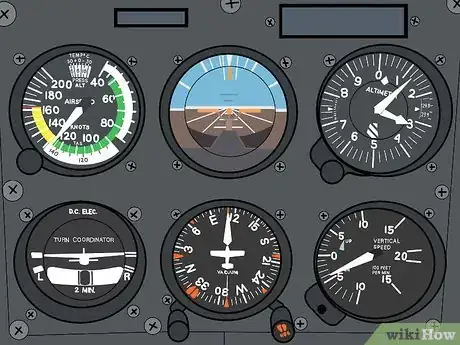
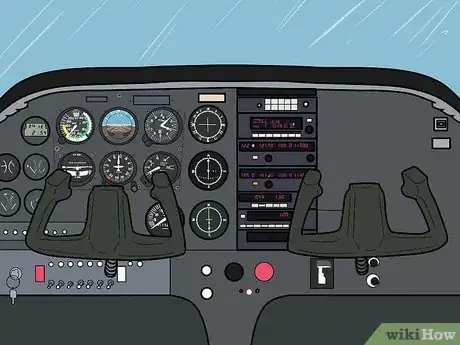
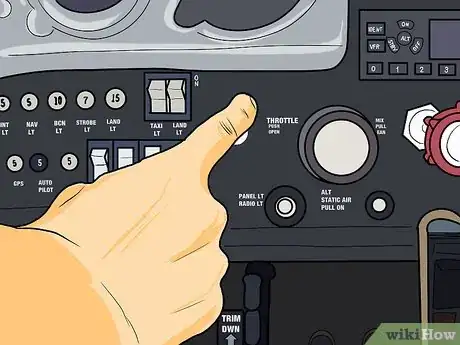
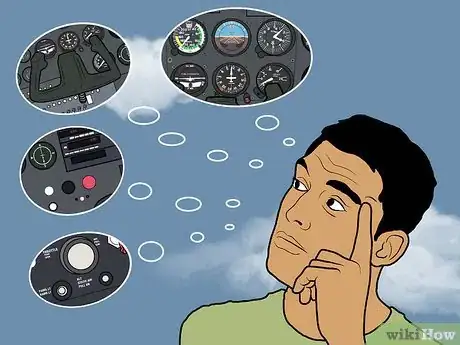


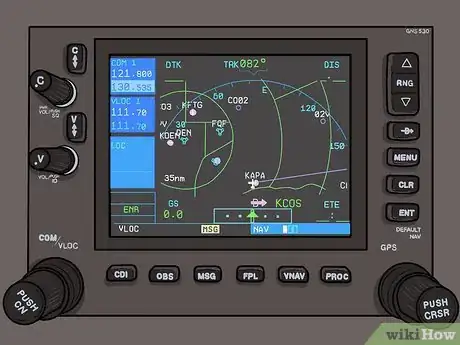

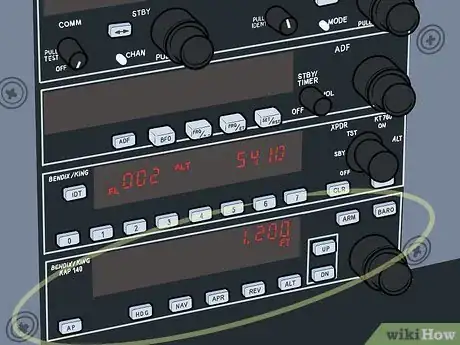
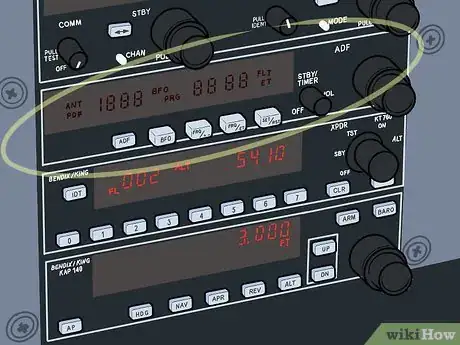
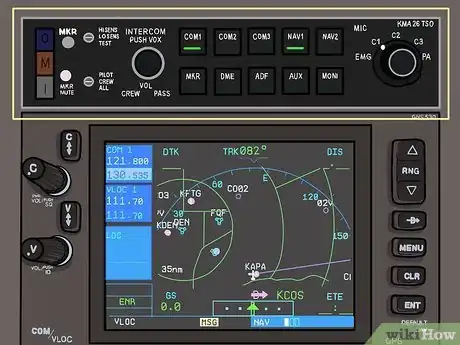
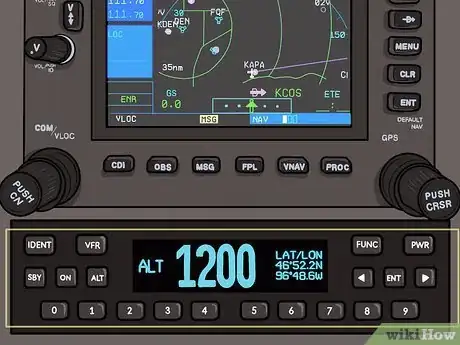
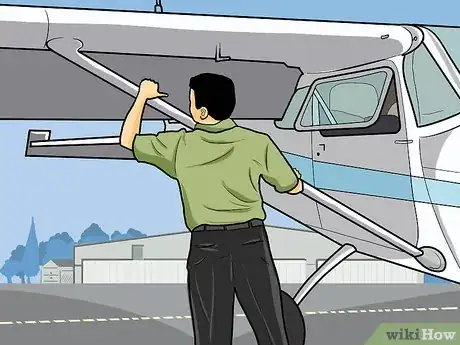
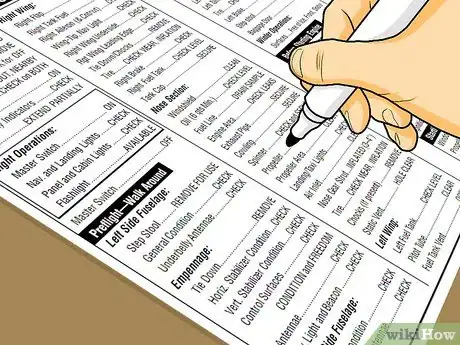
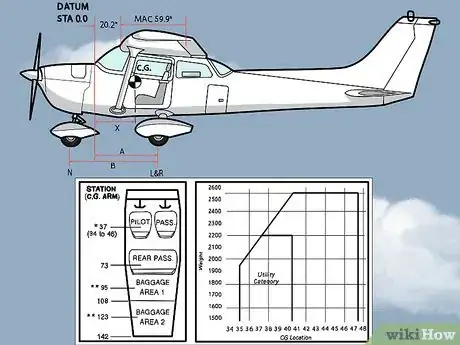




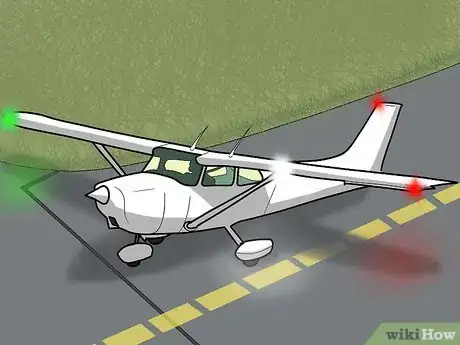





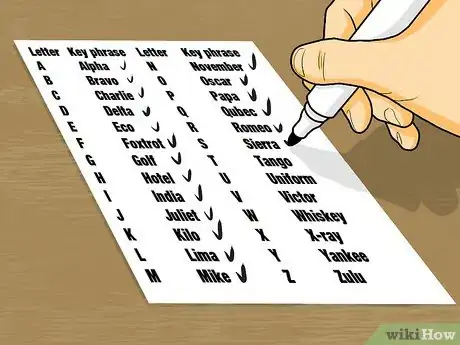


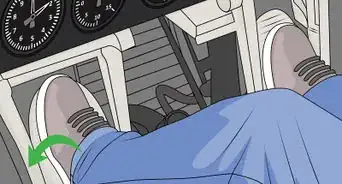



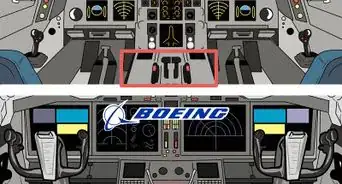
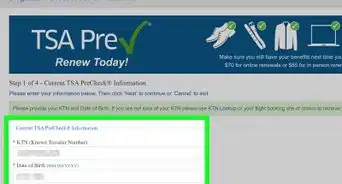
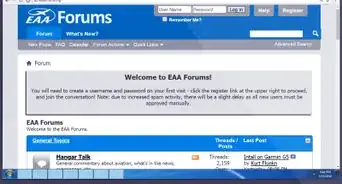
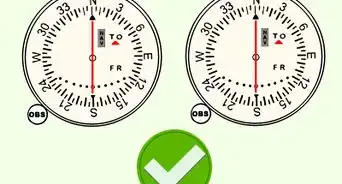
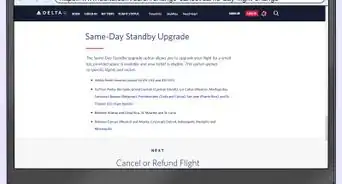

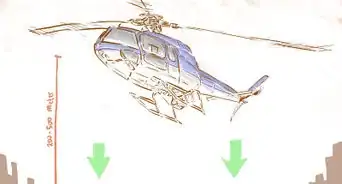

-Step-15.webp)











